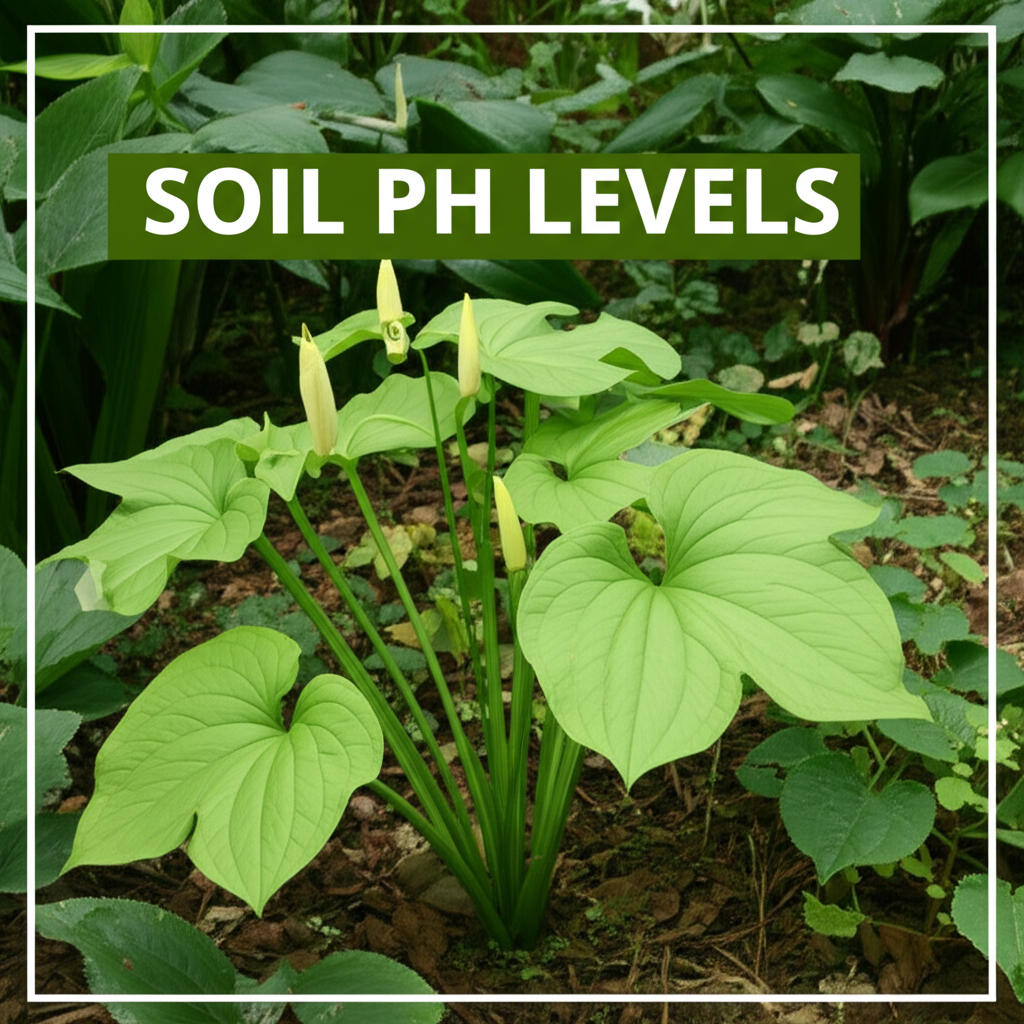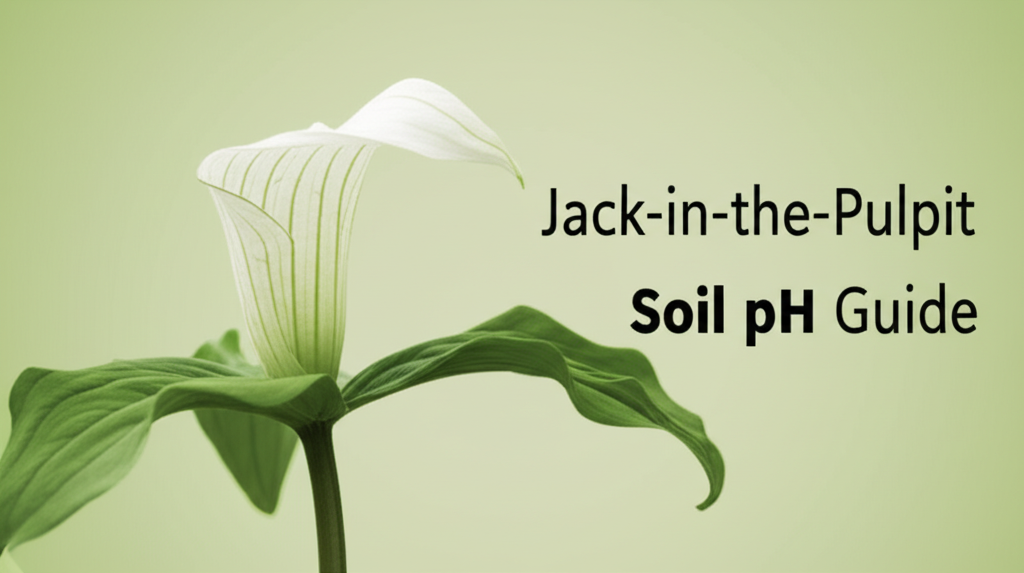Jack-in-the-Pulpit: A Botanical Enigma and Its Soil Needs
The Jack-in-the-Pulpit (Arisaema triphyllum), a captivating native woodland perennial, is renowned for its unique and almost theatrical bloom. This striking plant, with its hooded spathe and spadix resembling a preacher in a pulpit, is a beloved sight in shady, moist woodlands across eastern North America. While its aesthetic appeal is undeniable, successfully cultivating this botanical marvel hinges on understanding its specific soil requirements, particularly its preferred pH range. This guide delves deep into the world of Jack-in-the-Pulpit soil pH, providing everything a gardener needs to know to create the ideal environment for this fascinating plant.
Understanding Soil pH and Its Importance
Soil pH is a fundamental measure of the acidity or alkalinity of your soil. It’s expressed on a scale of 0 to 14, with 7 being neutral. Values below 7 indicate acidity, and values above 7 indicate alkalinity. This seemingly simple number plays a critical role in plant health because it directly influences the availability of essential nutrients to plant roots.
When soil pH is outside a plant’s preferred range, it can lock up vital nutrients, making them inaccessible even if they are present in the soil. This can lead to nutrient deficiencies, stunted growth, discolored foliage, and a general lack of vigor. For Jack-in-the-Pulpit, which thrives in specific woodland conditions, maintaining the correct soil pH is paramount to its survival and flourishing.
The Ideal pH Range for Jack-in-the-Pulpit
Jack-in-the-Pulpit generally prefers slightly acidic to neutral soil. The most commonly cited ideal pH range is between 5.5 and 6.5. While they can tolerate slightly wider variations, staying within this range will significantly increase your chances of success.
- Slightly Acidic (pH 5.5-6.0): This is often considered the sweet spot for Jack-in-the-Pulpit, mimicking the conditions found in their natural woodland habitats, where decaying organic matter tends to create a slightly acidic environment.
- Neutral (pH 6.0-6.5): Many Jack-in-the-Pulpit plants will also perform well in neutral soils, provided other conditions are met.
- Slightly Alkaline (pH 6.5-7.0): While they can tolerate this range, growth may be less vigorous, and nutrient uptake might be slightly compromised.
- Moderately to Highly Acidic (below 5.5) or Alkaline (above 7.0): These conditions are generally detrimental to Jack-in-the-Pulpit. In highly acidic soils, certain micronutrients might become too readily available, leading to toxicity. In alkaline soils, essential nutrients like iron and manganese can become unavailable, leading to chlorosis (yellowing of leaves).
Assessing Your Soil pH

Before you can adjust your soil pH, you first need to know what it is. Fortunately, there are several accessible methods for testing your soil.
Methods for Soil pH Testing
- Home Soil Test Kits: These are widely available at garden centers and online. They typically involve mixing a soil sample with distilled water and a reagent, then comparing the resulting color to a chart. Accuracy can vary, but they offer a good general indication.
- Digital pH Meters: For more precise readings, digital pH meters are a worthwhile investment for serious gardeners. These probes are inserted directly into the soil (or a soil-water slurry) and provide a digital pH reading. Ensure you calibrate your meter regularly according to the manufacturer’s instructions.
- Professional Soil Testing: Sending a soil sample to a local cooperative extension office or a private soil testing laboratory offers the most accurate and comprehensive analysis. These labs often provide detailed reports that not only include pH but also nutrient levels and recommendations for amendment.
Adjusting Soil pH for Optimal Jack-in-the-Pulpit Growth
Once you know your soil’s pH, you can take steps to adjust it if necessary. It’s important to remember that pH adjustments should be made gradually, as drastic changes can shock the plant and harm beneficial soil microbes.
How to Lower Soil pH (Make it More Acidic)
If your soil is too alkaline (pH above 6.5), you can lower it by incorporating acidic organic matter or using specific soil amendments.
- Adding Organic Matter: Incorporating materials like composted pine bark, peat moss, or composted oak leaves can gradually lower soil pH. These materials decompose and release organic acids.
- Sulfur-Based Amendments: Elemental sulfur is a common and effective amendment for lowering soil pH. The sulfur is converted to sulfuric acid by soil bacteria, which then neutralizes the soil’s alkalinity. The amount of sulfur needed depends on your soil type and the desired pH change. Follow product instructions carefully, and always work it into the soil.
- Acidifying Fertilizers: Fertilizers containing ammonium sulfate can also contribute to a more acidic soil over time.
How to Raise Soil pH (Make it More Alkaline)
If your soil is too acidic (pH below 5.5), you’ll need to raise its pH by adding alkaline materials.
- Lime: Ground limestone (calcium carbonate) is the most common amendment for raising soil pH. The type of lime (e.g., dolomitic or calcitic) will also add magnesium or calcium to the soil, respectively.
- Wood Ash: Wood ash can also raise soil pH, but it should be used with caution. It’s a potent amendment, and over-application can lead to a sharp increase in pH. Ensure the ash is from untreated wood.
- Bone Meal: While primarily a phosphorus source, bone meal can also contribute to a slight increase in soil pH.
Key Facts and Comparisons: Soil pH and Amendments
| Amendment | Typical Use | Primary Action | Potential Side Effects | Application Timing |
| :—————– | :————— | :—————— | :—————————————– | :———————- |
| Elemental Sulfur | Lowering pH | Increases acidity | Can burn roots if over-applied; slow acting | Fall or early spring |
| Ground Limestone | Raising pH | Increases alkalinity| Can add excess calcium/magnesium; slow acting | Fall or early spring |
| Peat Moss | Lowering pH/Improving soil structure | Adds acidity, improves drainage | Can be slow to decompose; some sources are not sustainably harvested | Anytime during soil prep |
| Composted Pine Bark| Lowering pH/Improving soil structure | Adds acidity, improves drainage | Can tie up nitrogen initially as it decomposes | Anytime during soil prep |
| Wood Ash | Raising pH | Increases alkalinity| Can cause sharp pH fluctuations; add sparingly | Apply lightly in fall |
Creating the Ideal Soil Environment Beyond pH
While pH is a critical factor, Jack-in-the-Pulpit has other soil preferences that contribute to its overall health and vitality.
Organic Matter Rich Soil
Jack-in-the-Pulpit thrives in soil that is rich in organic matter. This is crucial for several reasons:
- Nutrient Retention: Organic matter acts like a sponge, holding onto essential nutrients and making them available to the plant over time.
- Moisture Retention: Woodlands are typically moist environments. Organic matter helps the soil retain adequate moisture, preventing the corm from drying out.
- Aeration and Drainage: While moisture retention is important, good drainage is equally vital. A high organic matter content improves soil structure, allowing for better aeration and preventing waterlogging, which can lead to corm rot.
Incorporate generous amounts of compost, leaf mold, or well-rotted manure into your soil when preparing the planting site.
Consistent Moisture Levels
Jack-in-the-Pulpit prefers consistently moist soil, but not waterlogged conditions. They are often found in mesic woodlands, meaning they appreciate a steady supply of water, especially during their active growing season.
- Mulching: Applying a layer of organic mulch (such as shredded bark, leaves, or pine needles) around the base of the plant helps to retain soil moisture, suppress weeds, and regulate soil temperature.
- Watering: Water thoroughly when the top inch or two of soil feels dry. Avoid overhead watering, which can promote fungal diseases. Water at the base of the plant.
Shade and Woodland Conditions
Jack-in-the-Pulpit is a shade-loving plant. It typically grows in the understory of deciduous forests, receiving dappled sunlight or partial shade.
- Planting Location: Choose a location in your garden that receives filtered sunlight or morning sun and afternoon shade. Avoid full sun, which can scorch the leaves and dry out the soil too quickly.
- Companion Planting: Consider planting Jack-in-the-Pulpit alongside other woodland natives like ferns, hostas, or trilliums, which share similar light and moisture requirements.
Troubleshooting Common Soil-Related Issues
Even with the best intentions, you might encounter issues. Understanding how soil pH and other factors contribute to these problems can help you find solutions.
Yellowing Leaves (Chlorosis)
- Too Alkaline Soil: If your soil pH is too high, essential micronutrients like iron and manganese become unavailable, leading to yellowing leaves with green veins.
Solution: Test your soil pH and lower it by incorporating acidic organic matter or elemental sulfur if it’s above 6.5.
- Poor Drainage: Waterlogged soil can suffocate roots and also hinder nutrient uptake, potentially leading to similar yellowing.
Solution: Improve soil drainage by adding more organic matter, such as compost and perlite, to your planting bed.
Stunted Growth and Lack of Flowering
- Nutrient Imbalance: While not directly a pH issue, nutrient deficiencies or excesses (which can be linked to pH) can stunt growth.
Solution: Conduct a comprehensive soil test to identify any nutrient imbalances. Amend accordingly, focusing on balanced fertilization and adequate organic matter.
- Incorrect Light or Moisture: If the plant is not receiving enough light or is consistently too dry or too wet, it will struggle to grow and flower.
Solution: Adjust the planting location or watering schedule to meet the plant’s needs.
Corm Rot
- Waterlogged Soil: This is the most common cause of corm rot. The corm, which is the underground storage organ, cannot tolerate sitting in constantly saturated soil.
Solution:* Ensure excellent drainage. If your soil is heavy clay, incorporate significant amounts of compost and potentially coarse sand or perlite to improve aeration and drainage. Raised beds can also be a solution.
Steps to Success: Planting and Maintaining Jack-in-the-Pulpit
A systematic approach to planting and ongoing care will set you up for success with your Jack-in-the-Pulpit.
Steps for Planting and Soil Preparation
- Select the Right Location: Choose a spot with dappled shade or partial shade and consistently moist, well-draining soil.
- Test Your Soil pH: Before planting, test your soil pH. Aim for a range of 5.5 to 6.5.
- Amend the Soil: If your pH is outside the ideal range, make adjustments using appropriate amendments (sulfur for low pH, lime for high pH). Incorporate generous amounts of compost or other organic matter to enrich the soil.
- Plant the Corm: Plant the corm about 3-4 inches deep with the pointed end facing upwards.
- Water Thoroughly: After planting, water the area well to settle the soil and eliminate air pockets.
- Mulch: Apply a layer of organic mulch around the base of the plant, keeping it a few inches away from the stem.
Pros and Cons of Managing Soil pH for Jack-in-the-Pulpit
| Pros | Cons |
| :—————————————————————- | :———————————————————————- |
| Promotes vigorous growth and healthy foliage. | Can be time-consuming and require initial effort. |
| Increases the availability of essential nutrients. | Amendments need to be applied carefully to avoid overcorrection. |
| Reduces the risk of nutrient deficiencies and plant stress. | Results may not be immediate; pH adjustments take time. |
| Contributes to a more naturalistic woodland garden aesthetic. | Requires ongoing monitoring of soil conditions. |
| Enhances the plant’s ability to flower and produce berries. | Incorrect pH management can lead to plant decline or death. |
| Supports the overall health and resilience of the plant. | Some amendments, like peat moss, raise environmental concerns for some. |
Conclusion
The Jack-in-the-Pulpit is a rewarding plant to cultivate, offering a unique botanical spectacle for any shade garden. By understanding and catering to its specific soil pH requirements – ideally between 5.5 and 6.5 – along with its need for rich, moist, and well-draining soil, gardeners can create an environment where this woodland enigma truly thrives. Regular soil testing and appropriate amendments are key to unlocking the full potential of your Jack-in-the-Pulpit, ensuring its captivating presence for seasons to come. Happy gardening!
html
<h2>Jack-in-the-Pulpit Soil pH Guide: Key Facts/Comparison</h2>
<table>
<thead>
<tr>
<th>pH Range</th>
<th>Soil Type Recommendation</th>
<th>Nutrient Availability</th>
<th>Microbial Activity</th>
<th>Jack-in-the-Pulpit Preference</th>
</tr>
</thead>
<tbody>
<tr>
<td>4.5 - 5.5 (Acidic)</td>
<td>Rich, humusy, well-drained soils; often found in woodland settings. Can include pine needles, compost, and peat.</td>
<td>Iron, manganese, and aluminum are more soluble. Phosphorous availability can be reduced.</td>
<td>High for acid-loving microbes.</td>
<td><strong>Preferred</strong>. Mimics its native woodland habitat.</td>
</tr>
<tr>
<td>5.6 - 6.5 (Slightly Acidic to Neutral)</td>
<td>Loamy soils with good organic matter content. Can tolerate some clay if drainage is excellent.</td>
<td>Balanced availability of most essential nutrients, including phosphorous.</td>
<td>Diverse microbial populations.</td>
<td>Tolerated, but may not thrive as vigorously as in more acidic conditions.</td>
</tr>
<tr>
<td>6.6 - 7.0 (Neutral to Slightly Alkaline)</td>
<td>Can be problematic if alkaline. Requires amendments to lower pH and improve drainage.</td>
<td>Nutrient availability can be hindered, especially micronutrients like iron and manganese.</td>
<td>Activity may decrease for acid-preferring microbes.</td>
<td><strong>Generally not preferred</strong>. May show signs of chlorosis (yellowing leaves) due to nutrient deficiencies.</td>
</tr>
<tr>
<td>7.1+ (Alkaline)</td>
<td>Requires significant amendment with sulfur or acidic organic matter to lower pH. Poor drainage is often a concern.</td>
<td>Severe nutrient lockout, especially for essential micronutrients.</td>
<td>Very different microbial communities, not conducive to Jack-in-the-Pulpit health.</td>
<td><strong>Avoid</strong>. Will likely lead to poor growth and eventual decline.</td>
</tr>
</tbody>
</table>
<h2>Jack-in-the-Pulpit Soil pH Guide: Steps/Pros-Cons</h2>
<h3>Adjusting Soil pH for Jack-in-the-Pulpit</h3>
<table>
<thead>
<tr>
<th>Action</th>
<th>Purpose</th>
<th>Pros</th>
<th>Cons</th>
</tr>
</thead>
<tbody>
<tr>
<td>Testing Soil pH</td>
<td>Determine the current pH of your soil.</td>
<td>Essential for accurate amendment. Avoids over or under-amendment.</td>
<td>Requires a soil testing kit or lab analysis. May incur a small cost.</td>
</tr>
<tr>
<td>Adding Organic Matter (Compost, Leaf Mold, Peat Moss)</td>
<td>To lower pH and improve soil structure and moisture retention.</td>
<td>Naturally lowers pH (especially peat moss and pine needles). Improves drainage and aeration. Provides slow-release nutrients.</td>
<td>Can be labor-intensive. Peat moss is a non-renewable resource. May not significantly lower pH if soil is very alkaline.</td>
</tr>
<tr>
<td>Applying Elemental Sulfur</td>
<td>To significantly lower soil pH when it's too alkaline.</td>
<td>Effective for making long-term adjustments to pH.</td>
<td>Takes time to work (months). Over-application can severely damage plants. Requires careful measurement.</td>
</tr>
<tr>
<td>Applying Lime (Calcium Carbonate)</td>
<td>To raise soil pH (NOT recommended for Jack-in-the-Pulpit).</td>
<td>Raises pH, which is beneficial for many plants.</td>
<td><strong>Detrimental</strong> to Jack-in-the-Pulpit, as it increases pH and can lock up essential nutrients.</td>
</tr>
<tr>
<td>Using Acidifying Fertilizers (e.g., Ammonium Sulfate)</td>
<td>To slowly lower pH over time, primarily for maintenance.</td>
<td>Can provide nitrogen while slightly acidifying the soil.</td>
<td>Use with caution, as over-fertilization can harm plants. Not a primary method for drastic pH adjustment.</td>
</tr>
</tbody>
</table>


